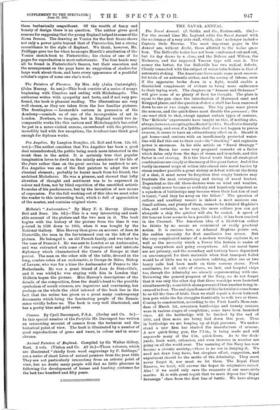C URRENT LITERATURE.
ART-BOOKS.
Two more volumes have been added to the "Great Masters Series" (G. Bell and Sons, 5s. each).—Piero dells Francesca, by W. G. Waters, is a well-written and interesting study of a great and highly individual painter. Piero was one of those who could strip off all the trappings and irrelevances of the things he wished to paint, and leave the central idea austerely naked. This result when attained by a great master leaves on us an indelible impression. The portrait of a man from the church of San Francesco at Arezzo is a notable example of the dignity that results from conscious simplicity; so is the splendid figure of the Virgin in the picture in the library of Christ Church at Oxford. For relentless portraiture it would be hard to match the head of Sigismondo Malatesta in the fresco at Rimini, with its resem- blance to a poisonous reptile, so appropriate to the character of the man painted. Mr. Waters never forgets that he is writing about a painter, and does not load his pages with allusions to contemporary Italian history, or swamp the central figure in petty but curious details fished up out of archives by German professors.—Pintorirchio. By E. M. Phillipps.—The author sums up the characteristics of the painter in the following words :— "The lyric faculty is his. He follows the lives, the histories, the fashions of his time with minute persistence, but always with some charm added to prosaic actuality : slight, garru- lous, naive, infectious. He has a haunting melody of his own, and through his eyes we watch the widening of one aspect of that golden day." Above all things, Pintoricclxio was a great decorator, as he showed both in the Borgia apartments at the Vatican and in the library at Siena. The author calls the former "rich yet unobtrusive," and speaks of their "refined splendour " ; most people, we imagine, would call
them barbarically magnificent. Of the wealth of fancy and beauty of design there is no question. The author gives good reasons for supposing that the young Raphael helped in some of the Siena frescos. The drawing at Venice for the first fresco shows not only a power quite beyond that of Pintoricchio, but a strong resemblance to the style of Raphael. We think, however, Mr. Phillipps goes too far when he accepts Morelli's attribution of the Venice sketch-book to Pintoriechio; his choice of one of its pages for reproduction is most unfortunate. The four heads may all be found in Pintoricchio's frescos, but their execution and the arrangement on the page have no suggestion of studies for large work about- them, and have every appearance of a youthful scholar's copies of some one else's work.





















































 Previous page
Previous page